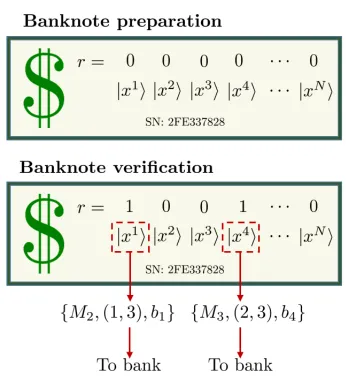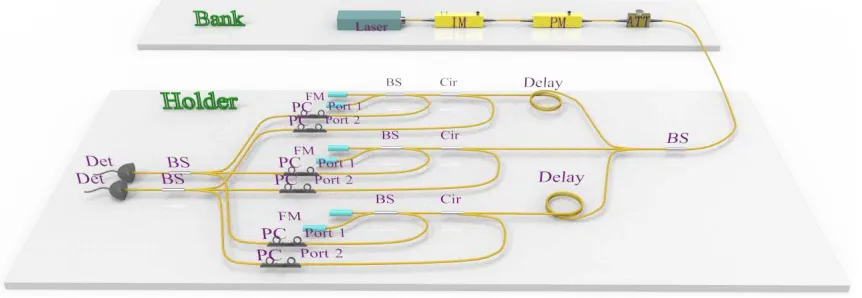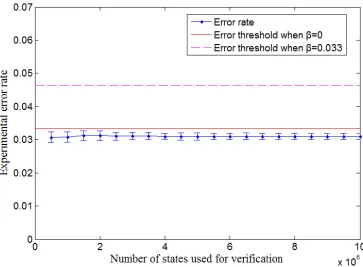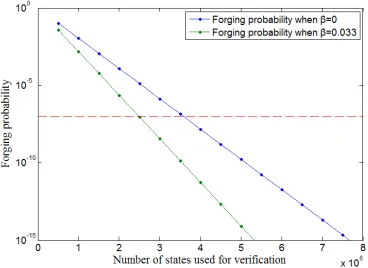Experimental preparation and verification of quantum money
Jian-Yu Guan,1, 2
Juan Miguel Arrazola,3
Ryan Amiri,4
Weijun Zhang,5 Hao Li,5 Lixing You,5 Zhen Wang,5 Qiang Zhang,1, 2 and Jian-Wei Pan1, 2
1Shanghai Branch, Hefei National Laboratory for Physical
Sciences at Microscale and Department of Modern Physics,
University of Science and Technology of China, Hefei, Anhui 230026, P. R. China
2CAS Center for Excellence and Synergetic Innovation Center in
Quantum Information and Quantum Physics, Shanghai Branch,
University of Science and Technology of China, Hefei, Anhui 230026, China
3Centre for Quantum Technologies, National University of Singapore,
3 Science Drive 2, Singapore 117543
4SUPA, Institute of Photonics and Quantum Sciences,
Heriot-Watt University, Edinburgh EH14 4AS, United Kingdom
5State Key Laboratory of Functional Materials for Informatics,
Shanghai Institute of Microsystem and Information Technology,
Chinese Academy of Sciences, Shanghai 200050, P. R. China
Abstract
A quantum money scheme enables a trusted bank to provide untrusted users with verifiable
quantum banknotes that cannot be forged. In this work, we report an experimental demonstration
of the preparation and verification of unforgeable quantum banknotes. We employ a security
analysis that takes experimental imperfections fully into account. We measure a total of 3.6×106
states in one verification round, limiting the forging probability to 10−7 based on the security analysis. Our results demonstrate the feasibility of preparing and verifying quantum banknotes
using currently available experimental techniques.
Remarkable progress has been made in quantum cryptography since its inception several decades ago. Quantum key distribution is widely considered to be one of the first practical quantum technologies [1–3], while many other protocols are beginning to shift from theo-retical proposals to experimental demonstrations. Examples of these are developments in quantum signature schemes [4–9], quantum fingerprinting [10–12], secure quantum compu-tation [13–16], covert communication [17–20], and bit commitment [21–24]. Despite these advances, quantum money – the first quantum cryptography protocol to be proposed – has only recently started to enter the realm of possible experimental implementations.
Quantum money was first introduced in a seminal paper by Wiesner in 1970 [25]. The goal of any quantum money scheme is to enable a trusted authority, the bank, to provide untrusted users with verifiable banknotes that cannot be forged. Many variants of Wiesner’s original scheme were found to be vulnerable to so-called “adaptive attacks” [26–28], which motivated the formulation of new quantum money protocols which are provably secure against unbounded quantum adversaries. Similarly, progress was made in developing simpler protocols that take into account experimental limitations. In Ref. [29], a secure quantum money protocol was proposed requiring only classical communication between a verifier and the bank. The issue of tolerance to experimental errors was first addressed in Ref. [30], with further developments in Refs. [31]. Recently, a practical protocol with nearly optimal noise tolerance was proposed in Ref. [32]. These developments have lead to the first quantum money experiments, with a demonstration of forging in Wiesner’s original scheme [33]. An unforgeable demonstration of quantum money remains experimentally challenging.
In this work, we present an experimental implementation of the quantum money scheme of Ref. [32], demonstrating the entire life-cycle of the quantum states contained in a quantum banknote: from preparation using a laser source and phase modulation, to verification using passive linear optics. We perform a security analysis of the protocol that takes full account of experimental imperfections. The setup allows for fast and efficient verification of quantum banknotes, compatible with on-chip realizations and storage in quantum memories, which may be performed in the future.
as the verification of the banknotes.
Quantum money protocol.– Any scheme for producing unforgeable quantum banknotes consists of a procedure from the bank to prepare the banknotes and a method to verify their authenticity. In this work, we implement the practical quantum money scheme of Ref. [32], which is based on hidden matching quantum retrieval games (QRGs) [29, 34]. In these QRGs, the bank encodes a four-bit classical stringx=x1x2x3x4 into a sequence of coherent states with amplitude α of the form
|α, xi:=|(−1)x1
αi |(−1)x2
αi |(−1)x3
αi |(−1)x4
αi. (1)
The verifier’s goal is to perform a measurement on|α, xithat allows her to retrieve the value of the parity bit b = xi⊕xj, where the possible (i, j) pairs are specified by the matchings
M1 ={(1,2),(3,4)}, M2 ={(1,3),(2,4)}, and M3 ={(1,4),(2,3)}. This measurement can be done by employing unbalanced Mach-Zehnder interferometers, as explained in detail later in this paper. These hidden matching QRGs form the building block of the quantum money protocol, as described below.
Banknote preparation
1. The bank independently and randomly chooses N strings of four bits which we will call x1, ..., xN.
2. The bank creates N quantum states |α, x1i, |α, x2i, . . . , α, xN
, which constitute the quantum banknote. The bank assigns a unique serial number to the banknote for identifi-cation.
3. The bank creates a classical binary register r and initializes it to 0N. This register keeps
a record of the states that have been previously used in the verification.
4. The bank creates a counter variable s and initializes it to 0. This counter keeps a record of the number of verification attempts for the banknote. The bank also have a pre-defined maximum number of allowed verifications T. The banknote should be returned to bank if s≥T.
Banknote verification
1. The holder randomly chooses a subset of indices L ⊂ [N] of size l = |L| such that rk = 0 for each k ∈ L. For each k ∈ L, the holder sets the corresponding bit of r to 1,
indicates these states will be measured.
2. For each k ∈ L, the holder picks a matching Mk at random from M1, M2, M3 and
applies the corresponding measurement to obtain outcome bk = xi ⊕ xj. If there is no
outcome, we setbi =∅. The number of successful outcomes is defined as l′.
3. The bank sets the efficiency threshold to be η −ǫ, where ǫ > 0 is a small positive security parameter. If l′ < l
min := (η−ǫ)l, the verifier aborts the protocol.
4. The holder sends all triplets (k,(i, j), bk) to the bank, who checks that s < T.
5. For each k, the bank checks whether the answer is correct by comparing (k,(i, j), bk)
to the secret xk values. The bank sets an error threshold to be β +δ, where δ is a small
positive constant. The bank accepts the banknote as valid only if fewer thanl′(β+δ) of the answers are incorrect.
6. The bank updates s to s+ 1.
The complete protocol is illustrated in Fig. 1. The security and correctness of this protocol was proven in Ref. [32], where it was shown that an honest verifier will correctly verify a valid banknote except with probability
P(Ver fails)≤exp
−2lminδ2
+ exp[−2lǫ2
] (2)
and the probability that an adversary can forge a banknote is bounded by
P(Forge)≤exp[−2ǫ
2
η2l] + exp[−2lǫ 2
] + exp[−2lminδ2]. (3)
Both of these probabilities decrease exponentially in the protocol parameter l. Besides, in our security analysis, the forging probability is larger than the probability of failing the verification, so we only take the former into account.
The parameters ǫandδare chosen to minimize the value of lnecessary to achieve a given security level. We use emin to represent the minimum average verification error rate for a forged coin. A natural choice for δ is δ = (emin −β)/2, i.e. half of the gap between the average error rate for a genuine coin and a forged coin. Security can always be obtained as long as β < emin. In the protocol, emin is bounded by [32]
FIG. 1: (Color online) Schematic illustration of the quantum money protocol. The bank produces
N quantum states x1
,x2
, . . . ,xN
according to a random secret string x=x1x2· · ·xN. The bank also assigns a unique serial number to the banknote and creates a register r that records
whether each state has been used previously for verification. To verify the banknote, a holder
randomly selects l quantum states. For each state, the holder randomly selects one of the three
matchings M1, M2, M3 and performs the corresponding measurement. The outcomes consist of a
matching pair (i, j) and a parity bitb, which are recorded and sent for comparison with bank’s secret
string x. The banknote is accepted as valid if the error rate observed by the bank is sufficiently
low.
FIG. 2: Experimental setup for generating and verifying quantum banknotes. A laser source
produces sequences of coherent states which are modulated in phase according to a secret stringx
and attenuated to an amplitude of|α|2 = 0.25. The signals are passively split into three arms using
a 1×3 beam-splitter and routed to three Mach-Zehnder interferometers. The interferometers –
which respectively have delays of 2 ns, 4 ns, and 6 ns – are implemented using a single beam-splitter
and Faraday mirrors. The delays are depicted in the figure in terms of the varying length of the
lower arm of the interferometer connected to the mirror. Delays of lengths 5 m, 10 m are placed to
distinguish the outputs of each interferometer, which are recombined using a 1×3 beam-splitter
and measured using superconducting nanowire single-photon detectors. IM: Intensity Modulator.
PM: Phase Modulator. ATT: Attenuator. BS: beam-splitter (2×2 and 1×3). Cir: Circulator.
FM: Faraday Mirror. PC: Polariser Controller.
protocol.
with amplifiers. The key data is then used to modulate the phase of the pulses. Finally, an attenuator adjusts the average photon number to an optimal level of |α|2 = 0.25. Each block is now a quantum state of the banknote, which is transmitted to the holder.
For verification of the banknote, the holder randomly selects a subset of all pulses and measures them. In this proof-of-principle experiment, this is done by measuring all states and selecting a random subset of all outcomes. Verification requires the holder to choose randomly between three different measurements, each corresponding to a different matching. This is achieved using a 1×3 beam-splitter (BS) to passively select between three Mach-Zehnder interferometers with delays of 2 ns, 4 ns, and 6 ns. The interferometers employ Faraday mirrors and a single beam-splitter to combine all possible pairings in the matchings. The result of interference implies phase relation between the corresponding two pulses. Thus, this allows the holder to retrieve information about the parity of the secret bits encoded in their phase.
Since the pulses in each block are separated by 2 ns, the 2 ns interferometer performs interference of the pairs (1,2),(2,3),(3,4), the 4 ns interferes pairs (1,3),(2,4), and the last interferometer interferes the pairing (1,4). This covers all six pairs in the matchings, allowing the holder to perform the banknote verification. At the output of the beam-splitter, delays of lengths 0 m, 5 m and 10 m are introduced to distinguish the outputs of the interferometers by their arrival time. Two 1×3 beam-splitters are used to recombine the output light of the interferometers. We use two superconducting nanowire single-photon detectors (SNSPDs) for detection. The SNSPDs have a desired polarization which corresponds to its maximum detection efficiency of 70%. At each output port of the interferometers, we use a polarization controller to adjust the polarization. Finally, the detection events are recorded by a time-digital converter (TDC) for analysis. The experimental setup is shown in Fig. 2.
FIG. 3: Experimental error rate for different values of the number of state used in verification l.
The standard error is calculated from 10 rounds of experiments. The red line shows the maximum
allowed error rate for passing the verification whenβ = 0, and the magenta dashed line shows the
threshold when β = 0.033. The banknotes generated in the experiment pass the verification in
both cases.
experimental rounds lie from 0.0336 to 0.0339, and the experimental error rate at different block size is shown in Fig. 3. Thus all our experiments can pass the verification.
The security of the quantum money protocol is quantified by the forging probability, which we set to 10−7
. The forging probability of our protocol is shown in Fig. 4, for the cases β = 0.033 and β = 0. The largest number of states needed occurs for β = 0, where at mostl = 3.6×106 states need to be measured in one verification round to ensure the desired security level, which actually decreases exponentially withl. This takes less than 350 ms in our experiment.
FIG. 4: Forging probability for different values of the number of state sused in verificationl. The
blue line corresponds to parameters β = 0.033 while the green line corresponds to parameters
β = 0. The dashed line represents the 10−7 target security level.
order to reach full applicability of quantum money schemes, it is crucial to be able to store the quantum states constituting the banknote in quantum memories. This remains a daunting challenge, but progress has been made rapidly in developing memories capable of storing the quantum states of optical modes as required by this money protocol [35–37]. Additionally, the interferometers used for verification are suitable for an implementation using integrated optics, which would allow a convenient method method for verifying quantum banknotes. Beyond their application to quantum money, our results demonstrate an implementation of quantum retrieval games (QRGs), which have the potential to be used as building blocks in other cryptographic protocols. This is an area worth exploring further. For example, it is intriguing to note the similarity between hidden matching QRGs and round-robin differential phase-shift QKD [38–40], a connection that may lead to new insights into these protocols.
we utilize high dimensional time-bin qudits based on the protocol of Ref. [32].
[1] C. H. Bennett and G. Brassard, Theoretical computer science560, 7 (2014).
[2] V. Scarani, H. Bechmann-Pasquinucci, N. J. Cerf, M. Duˇsek, N. L¨utkenhaus, and M. Peev,
Rev. Mod. Phys. 81, 1301 (2009).
[3] E. Diamanti, H.-K. Lo, B. Qi, and Z. Yuan, npj Quantum Information2, 16025 (2016).
[4] R. Amiri, P. Wallden, A. Kent, and E. Andersson, Physical Review A 93, 032325 (2016).
[5] J. M. Arrazola, P. Wallden, and E. Andersson, Quantum Information and Computation 16,
0435 (2016).
[6] R. Amiri and E. Andersson, Entropy 17, 5635 (2015).
[7] R. J. Collins, R. Amiri, M. Fujiwara, T. Honjo, K. Shimizu, K. Tamaki, M. Takeoka, M. Sasaki,
E. Andersson, and G. S. Buller, Scientific Reports 7 (2017).
[8] R. J. Collins, R. Amiri, M. Fujiwara, T. Honjo, K. Shimizu, K. Tamaki, M. Takeoka, E.
An-dersson, G. S. Buller, and M. Sasaki, Optics letters 41, 4883 (2016).
[9] H.-L. Yin, W.-L. Wang, Y.-L. Tang, Q. Zhao, H. Liu, X.-X. Sun, W.-J. Zhang, H. Li, I. V.
Puthoor, L.-X. You, et al., Physical Review A 95, 042338 (2017).
[10] J. M. Arrazola and N. L¨utkenhaus, Phys. Rev. A89, 062305 (2014).
[11] F. Xu, J. M. Arrazola, K. Wei, W. Wang, P. Palacios-Avila, C. Feng, S. Sajeed, N. L¨utkenhaus,
and H.-K. Lo, Nature Communications 6, 8735 (2015).
[12] J.-Y. Guan, F. Xu, H.-L. Yin, Y. Li, W.-J. Zhang, S.-J. Chen, X.-Y. Yang, L. Li, L.-X. You,
T.-Y. Chen, et al., Phys. Rev. Lett. 116, 240502 (2016).
[13] A. Broadbent, J. Fitzsimons, and E. Kashefi, inFOCS’09. 50th Annual IEEE Symposium on
Foundations of Computer Science, 2009. (IEEE, 2009), pp. 517–526.
[14] S. Barz, E. Kashefi, A. Broadbent, J. F. Fitzsimons, A. Zeilinger, and P. Walther, Science
335, 303 (2012).
[15] S. Barz, J. F. Fitzsimons, E. Kashefi, and P. Walther, Nature Physics 9, 727 (2013).
[16] C. Greganti, M.-C. Roehsner, S. Barz, T. Morimae, and P. Walther, New Journal of Physics
18, 013020 (2016).
[17] B. Sanguinetti, G. Traverso, J. Lavoie, A. Martin, and H. Zbinden, Physical Review A 93,
[18] B. A. Bash, A. H. Gheorghe, M. Patel, J. L. Habif, D. Goeckel, D. Towsley, and S. Guha,
Nature communications 6, 8626 (2015).
[19] J. M. Arrazola and V. Scarani, Physical Review Letters117, 250503 (2016).
[20] K. Bradler, T. Kalajdzievski, G. Siopsis, and C. Weedbrook, arXiv preprint arXiv:1607.05916
(2016).
[21] N. H. Y. Ng, S. K. Joshi, C. C. Ming, C. Kurtsiefer, and S. Wehner, Nature communications
3, 1326 (2012).
[22] T. Lunghi, J. Kaniewski, F. Bussi`eres, R. Houlmann, M. Tomamichel, A. Kent, N. Gisin,
S. Wehner, and H. Zbinden, Phys. Rev. Lett.111, 180504 (2013).
[23] Y. Liu, Y. Cao, M. Curty, S.-K. Liao, J. Wang, K. Cui, Y.-H. Li, Z.-H. Lin, Q.-C. Sun, D.-D.
Li, et al., Physical review letters 112, 010504 (2014).
[24] E. Verbanis, A. Martin, R. Houlmann, G. Boso, F. Bussi`eres, and H. Zbinden, Physical review
letters 117, 140506 (2016).
[25] S. Wiesner, ACM Sigact News 15, 78 (1983).
[26] S. Aaronson, inComputational Complexity, 2009. CCC’09. 24th Annual IEEE Conference on
(IEEE, 2009), pp. 229–242.
[27] A. Lutomirski, arXiv preprint arXiv:1010.0256 (2010).
[28] A. Brodutch, D. Nagaj, O. Sattath, and D. Unruh, Quantum Information and Computation
16, 1048 (2016).
[29] D. Gavinsky, in Computational Complexity (CCC), 2012 IEEE 27th Annual Conference
(IEEE, 2012), pp. 42–52.
[30] F. Pastawski, N. Y. Yao, L. Jiang, M. D. Lukin, and J. I. Cirac, Proceedings of the National
Academy of Sciences 109, 16079 (2012).
[31] M. Georgiou and I. Kerenidis, in LIPIcs-Leibniz International Proceedings in Informatics
(Schloss Dagstuhl-Leibniz-Zentrum fuer Informatik, 2015), vol. 44.
[32] R. Amiri and J. M. Arrazola, Physical Review A 95, 062334 (2017).
[33] K. Bartkiewicz, A. ˇCernoch, G. Chimczak, K. Lemr, A. Miranowicz, and F. Nori, npj Quantum
Information3, 7 (2017).
[34] J. M. Arrazola, M. Karasamanis, and N. L¨utkenhaus, Physical Review A93, 062311 (2016).
[35] N. Sinclair, E. Saglamyurek, H. Mallahzadeh, J. A. Slater, M. George, R. Ricken, M. P.
[36] M. G¨undo˘gan, P. M. Ledingham, K. Kutluer, M. Mazzera, and H. de Riedmatten, Physical
review letters 114, 230501 (2015).
[37] A. I. Lvovsky, B. C. Sanders, and W. Tittel, Nature photonics3, 706 (2009).
[38] J.-Y. Guan, Z. Cao, Y. Liu, G.-L. Shen-Tu, J. S. Pelc, M. Fejer, C.-Z. Peng, X. Ma, Q. Zhang,
and J.-W. Pan, Physical review letters 114, 180502 (2015).
[39] Y.-H. Li, Y. Cao, H. Dai, J. Lin, Z. Zhang, W. Chen, Y. Xu, J.-Y. Guan, S.-K. Liao, J. Yin,
et al., Physical Review A93, 030302 (2016).
[40] T. Sasaki, Y. Yamamoto, and M. Koashi, Nature 509, 475 (2014).
[41] M. Bozzio, A. Orieux, L. T. Vidarte, I. Zaquine, I. Kerenidis, and E. Diamanti, arXiv preprint



